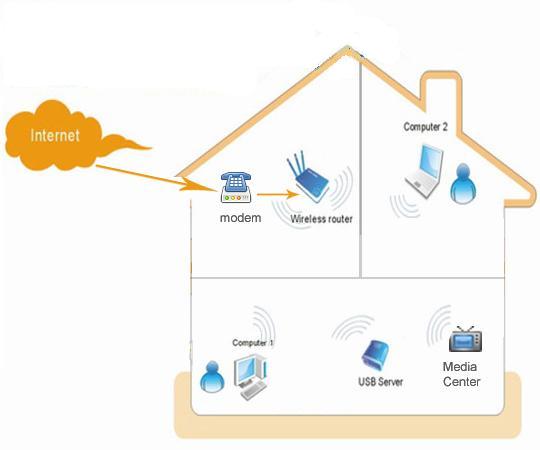| How can you make a better claim to your ISP? |
Complain to your ISP for poor quality of service is not an easy thing to do and event more difficult to "win". Almost always going to be as guilty by equipment installed, especially the WiFi router. In this paper, several methods that may be useful to be able to make better claims to your ISP. - Quentin Sherman Xue - CEO.
How can you make a better claim to your ISP? VTR in Chile for example.If you have a bad quality of the Internet in your home and go to complain to your ISP (Internet Service Provider), the first question is for the WiFi router installed. How I can answer if people of ISP guy says the problem is my router? It is true that not every probelm of Internet at home can be caused by your ISP. Indeed, sometimes it's your router. Most Chilean households (or other countries like U.S.) has this configuration:
CABLE COAXIAL - ISP MODEM DE - ROUTER WIFI - PCS/Notebooks 
Therefore, if there is problem of loss of Internet connection, you must first determine the location of disconnection, using PING command: 1. PING IP_ROUTER - pings from a PC to your router, for example for a DLINK router, ping -t 192.168.0.1 (from Windows), o ping 192.168.0.1 (from a Linux). If it works, it means that you are connecting from your PC to your router. On the contrary, if it fails, there are several possibilities: some routers, for example DLINK DIR Model 635, lose their connection to the PC when lifting the WAN connections (between router with modem). Or maybe your missed the connection between PC to your router. 2. PING IP_MODEM - most ISP modems IP is 192.168.100.1, you can determine if there is connectivity from your PC to the modem using command ping -t 192.168.100.1 (Windows) or ping 192.168.100.1 (Linux) With what argument can claim better your ISP?Unlike some other countries, the USA for example, in Chile, almost all modems are provided by the ISP directly. Moreover, almost never going to get a new modem, all are used. A modem that comes out of your house, will enter ISP's lab to be cleaned and installed in another house (with box as if new) The data provided by this modem can be very useful to make better claims to your ISP, if the case is caused by poor quality connection. You can see modem's data with a browser, google chrome, firefox or Internet Explorer: http://192.168.100.1, then click "Logs", you will see a screen like this:
If there is an item says "Modem Is Shutting Down and Rebooting", Internet service has problems, and it is the responsibility of the ISP. With this, you have the argument and evident to "win" to your ISP, so that it makes a repair and payment discounts (this is what hurts them). If you are interested in having more technical arguments that avoid you from feeling like you are "cheated" with pure storytelling, you click "Signal" and you will a screen like this:
The acceptable ranges are:
To make well argued claim, you must register these data for days, it's recommended to ask your ISP to conduct monitoring of the modem so that they also record these values, so when you call your ISP, with these (bad) values in your hand, can require the ISP to perform the repqairs to improve these values. Tool to record model valuesIf you want to record these values from the modem, you can use this script in Linux: [root@localhost ~]# more register_modem_vtr.sh#!/bin/bashwhile truedo x=`date` y=`wget -q -O - http://192.168.100.1/RgSignal.asp | grep "dB" | sed -e 's/]*>/ /g' | awk '{printf("%s",$0);}'` z=`date` echo -ne $x"-"$z $y"\r\n" >> /root/vtr.log sleep 60 done[root@localhost ~]# With this script running on a Linux server (obviously must be connected to your home network), the content of file /root/vtr.log, you can get results like this: Fri Feb 5 15:25:31 CLST 2010-Fri Feb 5 15:25:31 CLST 2010 Signal To Noise Ratio 35.4 dB Power Level -11.5 dBmV Power 49.8 dBmV Fri Feb 5 15:26:31 CLST 2010-Fri Feb 5 15:26:31 CLST 2010 Signal To Noise Ratio 35.6 dB Power Level -11.5 dBmV Power 51.0 dBmV Fri Feb 5 15:27:31 CLST 2010-Fri Feb 5 15:27:31 CLST 2010 Signal To Noise Ratio 35.6 dB Power Level -11.5 dBmV Power 51.3 dBmV Fri Feb 5 15:28:31 CLST 2010-Fri Feb 5 15:28:32 CLST 2010 Signal To Noise Ratio 35.6 dB Power Level -11.4 dBmV Power 51.3 dBmV Fri Feb 5 15:29:32 CLST 2010-Fri Feb 5 15:29:32 CLST 2010 Signal To Noise Ratio 35.6 dB Power Level -11.5 dBmV Power 51.3 dBmV Fri Feb 5 15:30:32 CLST 2010-Fri Feb 5 15:30:32 CLST 2010 Signal To Noise Ratio 35.7 dB Power Level -11.4 dBmV Power 51.3 dBmV Fri Feb 5 15:31:32 CLST 2010-Fri Feb 5 15:31:32 CLST 2010 Signal To Noise Ratio 36.0 dB Power Level -10.8 dBmV Power 54.0 dBmV Fri Feb 5 15:32:32 CLST 2010-Fri Feb 5 15:32:32 CLST 2010 Signal To Noise Ratio 35.5 dB Power Level -11.5 dBmV Power 62.2 dBmV Fri Feb 5 15:33:32 CLST 2010-Fri Feb 5 15:33:32 CLST 2010 Signal To Noise Ratio 35.6 dB Power Level -11.5 dBmV Power 51.5 dBmV Fri Feb 5 15:34:32 CLST 2010-Fri Feb 5 15:34:33 CLST 2010 Signal To Noise Ratio 35.7 dB Power Level -10.9 dBmV Power 54.0 dBmV Fri Feb 5 15:35:33 CLST 2010-Fri Feb 5 15:35:33 CLST 2010 Signal To Noise Ratio 35.9 dB Power Level -11.1 dBmV Power 55.0 dBmV Fri Feb 5 15:36:33 CLST 2010-Fri Feb 5 15:36:33 CLST 2010 Signal To Noise Ratio 35.7 dB Power Level -11.2 dBmV Power 54.0 dBmV Fri Feb 5 15:37:33 CLST 2010-Fri Feb 5 15:37:33 CLST 2010 Signal To Noise Ratio 36.0 dB Power Level -11.1 dBmV Power 55.0 dBmV Fri Feb 5 15:38:33 CLST 2010-Fri Feb 5 15:38:33 CLST 2010 Signal To Noise Ratio 36.0 dB Power Level -10.9 dBmV Power 54.0 dBmV In this way, you can go to discuss with your ISP with read data. As you see in this log example, there is a record for each minute, the TX-power values from 15:26 hours are totally bad, actually ran about 30 minutes without Internet entirely
2010 chile-offshore - all rights reserved.
|

